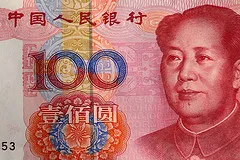
China’s CPI to be around 6% in August
And manufacturing PMI could weaken further, possibly falling below 50.
According to Standard Chartered, Beijing should start loosening monetary policy moderately.
Here’s more from StanChart:
| Inflation worries are giving way to concerns over the faltering global economic recovery. While CPI inflation edged higher to 6.5% y/y in July from 6.4% in June, we believe inflation pressures have now peaked. This view is supported by the slowdown in m/m CPI inflation to 6.7% from 10.8%, on a seasonally adjusted annualised rate (SAAR) basis, as well as slower real activity data. We think the August CPI print, to be released on 9 September, should be around 6% y/y, and manufacturing PMI could weaken further, possibly falling below 50. July industrial production growth, at 14% y/y, was much lower than the market expected, even taking into account the impact of a strong production number in June. It is difficult to worry about imported inflation in an environment of slower global growth, and as we discuss below, pork price rises look to be slowing. Recent US data and market volatility also reinforce our view that there will be no more interest rate hikes from The next move from Beijing will be to loosen monetary policy, albeit moderately, we believe. They clearly have to walk a fine line. In H1-2008, China kept tightening for too long while growth momentum in the West was clearly fading. Consequently, a huge fiscal stimulus package had to be rolled out after the onset of the global financial crisis in September 2008. China’s policy makers will not want to make the same mistake twice. But at the same time, they know that inflation could come back quickly – and at the back of their minds, they must worry that any move to QE3 from the Federal Reserve could propel commodity prices up. Policy is heavily dependent upon the data, but we think there is a good chance that China will move quietly to loosen by end-September. The People’s Bank has already injected liquidity into the inter-bank market to bring 7-day repo back down to just above 3%, from its peak of over 9% in late June. This policy loosening is likely to take the form of a less restrictive loan quota and increased budgetary spending on infrastructure and social housing. Both will probably take place quietly. If Beijing wanted to make headlines and boost confidence, a cut in the reserve requirement ratio (RRR) from the current 21.5% would be a relatively cost-free move. How far Beijing will move from there will depend on growth in the US, the EU and China, and on overall sentiment. Given lingering sovereign debt problems, the need to deleverage further, and an empty policy toolkit, the outlook for the West can hardly be giving Beijing much comfort. Some detail on the inflation numbers CPI inflation has peaked, in our view. The y/y print rose marginally in July to 6.5% y/y (from 6.4% prior), but on a m/m SAAR basis, CPI inflation slowed to 6.7% from 10.8%, according to our calculations. The current bout of inflation is the lagged consequence of money oversupply in 2009-10 and an overheating economy in H2-2010. M2 growth is now back under control, and real activity indicators have slowed considerably, suggesting that the economy is now growing around or even below potential. CPI inflation should therefore now start to slow. Both food and non-food inflation moderated in m/m terms in July. Food inflation slowed significantly to 19.5% m/m SAAR from 30.5% in June, while non-food inflation moderated to 0.16% from 1.7%. In the last 10 days of July, wholesale pork prices at Beijing’s Xinfadi market fell to about CNY 24 per kilo from CNY 26.7 per kilo at midmonth – an encouraging sign that pork prices are beginning to stabilise. The upward movement in nationwide pork prices has slowed. The pork-free CPI is more or less flat on a year-on-year basis. July PPI inflation was pushed higher by base effects, to 7.5% y/y from 7.1% prior. In m/m terms, price declines widened to 1.5% SAAR in July from 0.8% in June. Notably, prices of mining products and raw materials declined by 31% and 1.2% m/m SAAR in July, respectively, alleviating inflationary pressures at the upstream end of the supply chain.
|
Photo credit: wmliu



![SBR 5 Lorem Ipsum News 2 [8 May]](https://cmg-qa.s3.ap-southeast-1.amazonaws.com/s3fs-public/styles/exclusive_featured_article/public/2025-05/a_hand_pointing_to_a_futuristic_technology_5b87c9d0e3_3.png.webp?itok=M3Hf-9XR)
![SBR 4 Lorem Ipsum [8 May Top Stories]](https://cmg-qa.s3.ap-southeast-1.amazonaws.com/s3fs-public/styles/exclusive_featured_article/public/2025-05/a_hand_pointing_to_a_futuristic_technology_5b87c9d0e3_2.png.webp?itok=2m5Wl0MX)


![Exclusive three SBR 12 Lorem Ipsum [8 May]](https://cmg-qa.s3.ap-southeast-1.amazonaws.com/s3fs-public/styles/exclusive_featured_article/public/2025-05/a_hand_pointing_to_a_futuristic_technology_5b87c9d0e3_11.png.webp?itok=8kn_UIfA)
![SBR 3 Lorem Ipsum [ Exclusive 2]](https://cmg-qa.s3.ap-southeast-1.amazonaws.com/s3fs-public/styles/exclusive_featured_article/public/2025-05/a_hand_pointing_to_a_futuristic_technology_5b87c9d0e3_1.png.webp?itok=YCyjLegJ)
![SBR 2 Lorem Ipsum [8 May]](https://cmg-qa.s3.ap-southeast-1.amazonaws.com/s3fs-public/styles/exclusive_featured_article/public/2025-05/a_hand_pointing_to_a_futuristic_technology_5b87c9d0e3_0.png.webp?itok=_cKD-29o)

![Video [Event News]](https://cmg-qa.s3.ap-southeast-1.amazonaws.com/s3fs-public/styles/event_news_featured_article/public/2025-05/screenshot-2025-05-08-at-4.58.53-pm_0.png.webp?itok=Kud35sMs)
![Event News SBR 9 Lorem Ipsum [8 may]](https://cmg-qa.s3.ap-southeast-1.amazonaws.com/s3fs-public/styles/event_news_thumbnail/public/2025-05/a_hand_pointing_to_a_futuristic_technology_5b87c9d0e3_8.png.webp?itok=DTh_dbYp)
![Event News SBR 9 Lorem Ipsum [8 May]](https://cmg-qa.s3.ap-southeast-1.amazonaws.com/s3fs-public/styles/event_news_thumbnail/public/2025-05/a_hand_pointing_to_a_futuristic_technology_5b87c9d0e3_7.png.webp?itok=vzDAzb6V)
![Event News SBR 8 Lorem Ipsum [8 May]](https://cmg-qa.s3.ap-southeast-1.amazonaws.com/s3fs-public/styles/event_news_thumbnail/public/2025-05/a_hand_pointing_to_a_futuristic_technology_5b87c9d0e3_6.png.webp?itok=jvHFc4P6)
![Video [Event News]](https://cmg-qa.s3.ap-southeast-1.amazonaws.com/s3fs-public/styles/video_thumbnail/public/2025-05/screenshot-2025-05-08-at-4.58.53-pm_0.png.webp?itok=yZnI0YBb)
![Video 1 SBR [8 May]](https://cmg-qa.s3.ap-southeast-1.amazonaws.com/s3fs-public/styles/video_thumbnail/public/2025-05/screenshot-2025-05-08-at-4.58.53-pm.png.webp?itok=9AAeRz_k)

 Advertise
Advertise

